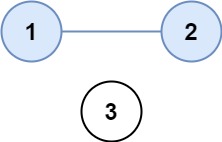547. Number of Provinces
Description
There are n cities. Some of them are connected, while some are not. If city a is connected directly with city b, and city b is connected directly with city c, then city a is connected indirectly with city c.
A province is a group of directly or indirectly connected cities and no other cities outside of the group.
You are given an n x n matrix isConnected where isConnected[i][j] = 1 if the i^th city and the j^th city are directly connected, and isConnected[i][j] = 0 otherwise.
Return the total number of provinces .
Example 1:

1 | Input: isConnected = [[1,1,0],[1,1,0],[0,0,1]] |
Example 2:

1 | Input: isConnected = [[1,0,0],[0,1,0],[0,0,1]] |
Constraints:
1 <= n <= 200n == isConnected.lengthn == isConnected[i].lengthisConnected[i][j]is1or0.isConnected[i][i] == 1isConnected[i][j] == isConnected[j][i]
Hints/Notes
- 2025/04/12 Q2
- union find
- 0x3F’s solution
Solution
Language: C++
1 | class Solution { |